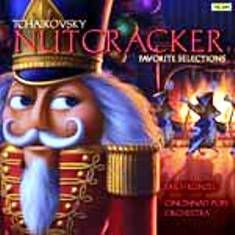
Paavo Järvi: Cincinnati Symphony Orchestra. Tchaikovsky, "Romeo and Juliet" Overture Fantasy. Symphony No. 6 ("Pathetique"). Telarc A.
Here's music to move you, no matter how many times you have heard it. Sorrow is the overriding emotion in Tchaikovsky's 'Romeo and Juliet' and in his valedictory, "Pathetique" symphony, both works are beautifully, sensitively rendered by Järvi and the CSO. The pacing of the music, its peaks and valleys and the clarity and quality of Telarc's audiophile sound project deep feeling.
The tone poem "Romeo and Juliet" is based on Shakespeare's play. Järvi begins it exquisitely, more slowly and thoughtfully than most, with sudden fortes that sound like sobs. When the love theme arrives, he treats it with the utmost tenderness, as if allowing the lovers a moment of happiness before the ax falls. And fall it does, with a thud of timpani. The final sad wind chorale and love theme/elegy give way to stern staccato chords and a broad, very Russian sounding end.
Tchaikovsky never divulged the "meaning" of his "Pathetique" Symphony (though it had one, he said). The title was suggested by a friend and Tchaikovsky asked that it be removed, but he died nine days after the premiere and it stuck. Tragedy clings to the work, perhaps for that reason, and it begins and ends in emotion-laden darkness.
Järvi's reading is highly dramatic. Prepare yourself (if you can) for the thunder clap fortissimo that opens the development section in the first movement. He shapes the lovely second theme touchingly, ending the movement in a huge outpouring of grief.
The middle movements bear the optimism of the work. The CSO cellos all but laugh in the famous 5/4 waltz. The blustery march/scherzo features snappy rhythms and swirling strings. However, the final Adagio, in which a theme from the waltz becomes a threnody, is wrenching in its despair.
Available in CD and SCAD formats.

Erich Kunzel: Cincinnati Pops Orchestra. Tchaikovsky, "Nutcracker." Favorite Selections. Telarc. A.
Hear the other Tchaikovsky, of ballet barres and children's dreams, on Kunzel and the Pops' latest Telarc release, selections from "The Nutcracker" ballet.
You'll find all of your favorites here -- 73 minutes -- worth from "Mother Ginger and Her Little Clowns" to "The Dance of the Sugar Plum Fairy."
It's Kunzel and the Pops' 84th CD for Telarc and a must for holiday listening.
Arranged in two acts and 17 scenes, there are 23 selections in all, beginning with the sparkling, light-footed Overture.
The familiar March is all brassy spit and polish. Highlight of the first tableau (scenes 1-6) is "The Magic Spell Begins," which morphs from suspenseful to splendorous as the chimes strike twelve, the Christmas tree grows and the room becomes a pine forest.
The second tableau (scenes 8 and 9), set in the forest, features the glittering Waltz of the Snowflakes" with the Cincinnati Children's Choir directed by Robyn Lana.
The Prince makes his heroic entrance in act II, followed by the well known divertissements, including the Spanish, Arabian, Chinese and Russian Dances, "Dance of the Mirlitons" (reed flutes) and Mother Ginger.
"Waltz of the Flowers" gets a lilting, harp-laced reading, and you can almost see the Sugar Plum Fairy and the Prince executing leaps and lifts in their Pas de deux.
Pops keyboardist Julie Spangler does the honors on celesta in "Dance of the Sugar Plum Fairy." Smell the rosin from toe shoes and bows in "Final Waltz and Apotheosis," which ends the ballet on a great big timpani roll flourish..
CD and SACD formats.